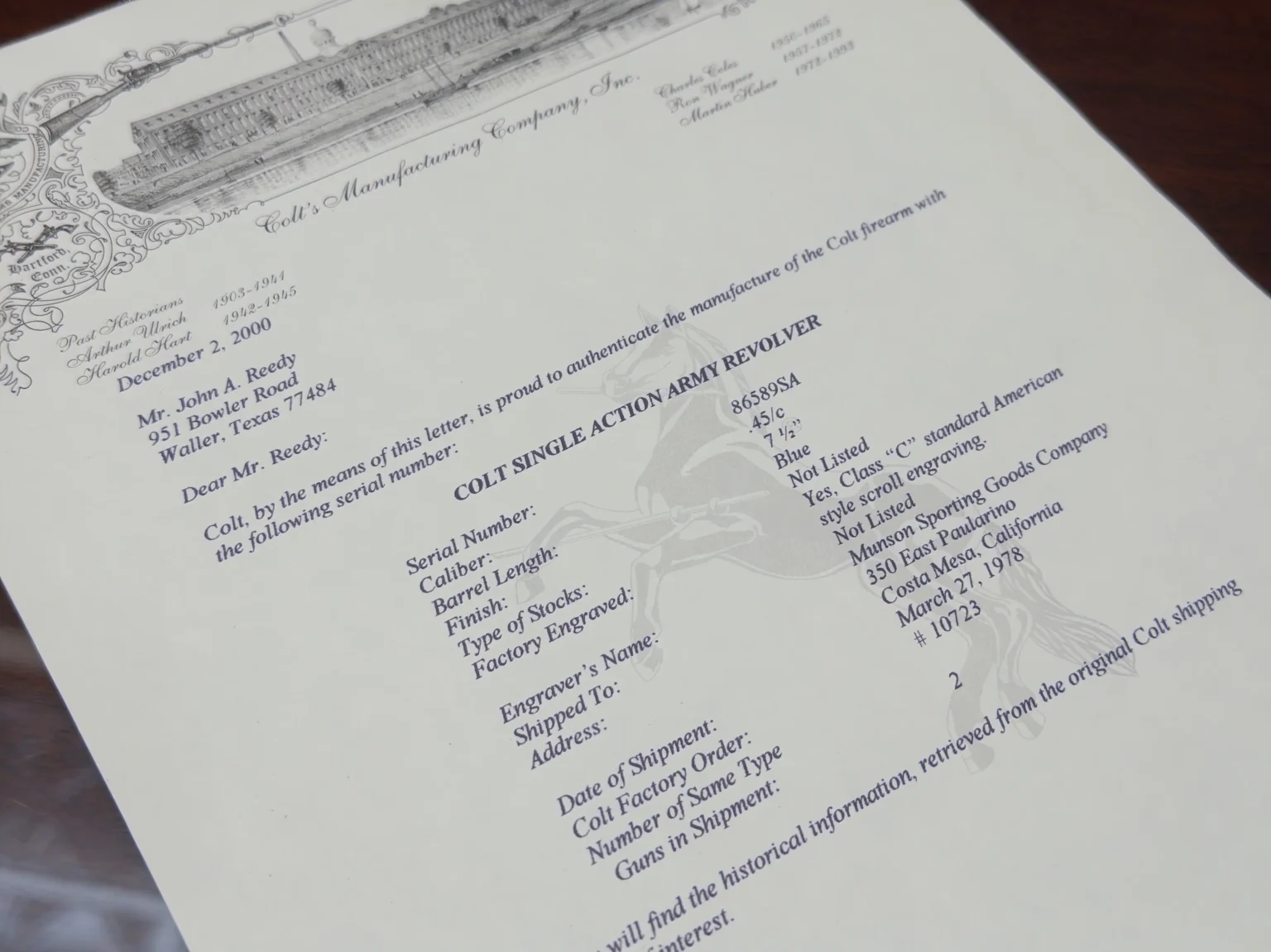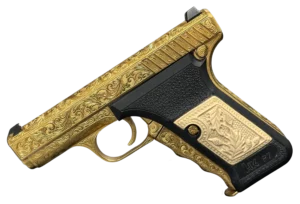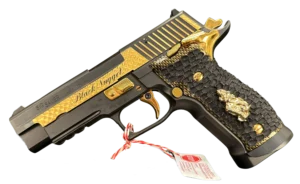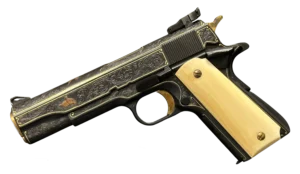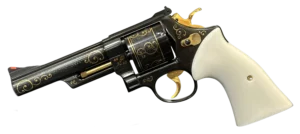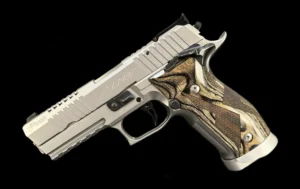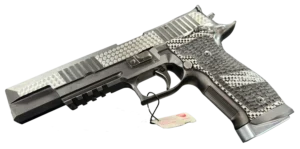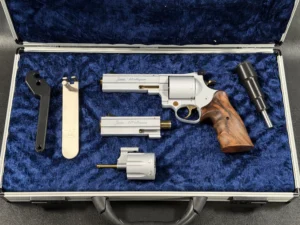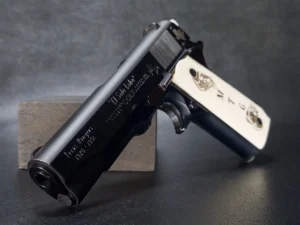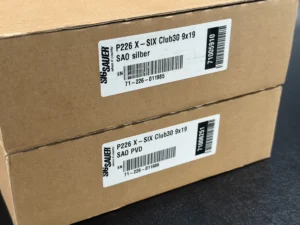Key Takeaways:
- Provenance is the heartbeat of collecting: It’s not just about owning an old gun, it’s about knowing where it’s been. The letters, receipts, and photos that tell its story can turn a simple firearm into a living piece of history.
- Paper trails matter more than polish: A factory letter or an old invoice can do more for authenticity than the gun’s condition ever could. The story behind it, who owned it, where it went, what it witnessed often ends up being the real treasure.
- You’re not just collecting objects, you’re preserving lives: Every firearm with a traceable past holds echoes of the people who made, carried, and cared for it. When you uncover and protect that history, you’re doing more than building a collection; you’re keeping their stories alive.
In the world of firearm collecting, few words carry as much weight or spark as much excitement as provenance. You’ve probably heard it tossed around at auctions or whispered at gun shows, usually followed by a story that starts with, “You’re not going to believe who owned this one…”
Provenance isn’t just a fancy word for paperwork. It’s the story. The life a firearm lived before it landed in your hands. Every scratch, every engraving, every receipt folded into a yellowed envelope tells a piece of that journey. Sometimes those stories are tidy and well-documented, and sometimes they’re half-mystery, half-luck.
For collectors, provenance is more than a technicality. It’s what turns a firearm from a well-made object into something that matters.
What Is Provenance and Why It Matters
At its core, provenance is the documented history of an item, the record of where it came from, who owned it, and what it’s been through. Sounds simple, right? Except it never really is.
In the firearm world, provenance can be a handful of factory records confirming the gun’s shipment date and destination, or it can be a trail of letters, auction listings, and even personal notes from a soldier, hunter, or craftsman. Sometimes the proof lies in a single name etched into the grip.
So, why does it matter?
Because provenance is proof. Proof that a Colt really did ship to a cavalry officer in 1874. Evidence that a Luger was part of a special contract run. Proof that the old Smith & Wesson sitting in someone’s drawer once belonged to a champion shooter. Without provenance, you’re just guessing and guessing, and in this field, it can be expensive.
But there’s another reason it matters: connection. Provenance lets you touch history, not metaphorically but almost physically. You can hold a piece and think, someone else held this during a war, a duel, a competition. It makes history intimate.
Collectors talk about value all the time and yes, provenance can skyrocket the price of a firearm. But if you ask most seasoned collectors, the real draw isn’t money. It’s the thrill of the chase, the detective work, and that feeling when you finally find the missing page that ties it all together.
That’s what keeps people hooked.
The Value of Provenance in Collector Firearms
Let’s be honest, provenance is the difference between a firearm that sells for a few thousand and one that makes the auction house buzz. A well-documented story doesn’t just add a number to the price tag; it gives the piece gravity.
Imagine two identical Colt Single Action Army revolvers. One comes with a plain box. The other comes with a file folder containing a letter from Colt Archives stating it was shipped to the Texas Rangers in 1891. Which one would you rather have?
Exactly.
Provenance transforms an object into a narrative. It takes cold metal and makes it human. A firearm that was just another production model becomes the gun carried by a particular officer, or presented as an award, or used in a famous match.
And that story, when verified, can multiply value. Museums, serious collectors, and even investors hunt for that magic blend: authenticity and history. The more detailed and verifiable the provenance, the stronger the piece’s appeal.
But value isn’t only financial. Provenance is emotional currency, too. It adds weight to ownership. Knowing you’re not just holding a Winchester 1873, but that Winchester 1873, the one from a prospector’s camp during the Gold Rush — changes how you see it.
You’re not just collecting; you’re preserving.
Key Elements of Provenance Documentation
If you’ve ever gone down the rabbit hole of tracing a firearm’s past, you know the paper trail can be surprisingly complicated or frustratingly thin. Still, certain documents consistently rise to the top of what collectors call “good provenance.”
Let’s break down what actually matters.
1. Original Sales Records or Receipts
This is the holy grail of starting points, proof of that first transaction. It might be a simple invoice from a hardware store in 1902 or a note from Colt’s shipping department. Either way, it’s the moment the gun left the factory’s hands.
2. Factory Letters
More on these later, but think of them as official birth certificates. Issued by manufacturers like Colt, Smith & Wesson, or Winchester, they confirm serial numbers, models, shipping dates, and destinations. If provenance had a gold standard, this would be it.
3. Historical Documents or Certificates
Newspaper clippings, military records, and museum archives can all fill in the blanks. Maybe the firearm appeared in a photograph, or was listed in an estate inventory. Every document helps weave a fuller picture.
4. Records of Repairs or Modifications
Guns evolve. Maybe a grip was replaced, or a barrel shortened. Knowing when and by whom those changes happened can explain physical inconsistencies and support authenticity.
5. Previous Sale or Auction Records
Auction catalogs often preserve rich detail. Provenance sometimes gets lost between owners, so finding a prior sale listing can reattach an essential link in the chain.
6. Personal Correspondence or Ownership Notes
Letters, diaries, or even a scrawled note on an envelope can mean more than you’d expect. Maybe it’s a line that reads, “Carried this Colt through France in ’44.” That’s the kind of quiet evidence collectors live for.
The real magic happens when these pieces come together. Each document alone might not say much. But together? They create a timeline, a life story, and that’s when provenance stops being paperwork and starts being history.
Factory Letter Authentication: The Gold Standard
Now, about those factory letters. If you’ve spent any time in collector circles, you know these are treated almost reverently — and for good reason.
A factory letter is essentially a manufacturer’s official record confirming when and where your firearm was shipped. That’s it, but that’s everything. For instance, Colt has the Colt Archive Properties office, which can tell you if your revolver was shipped to a U.S. Army depot in 1890 or to a hardware store in St. Louis.
It might sound simple, but those details can rewrite a firearm’s story.
I’ve seen collectors discover that a gun they thought was ordinary was actually part of a special order or presentation batch. One letter can turn “nice old Colt” into “historically significant artifact.”
A typical factory letter includes:
- The date the gun left the factory
- Where it was shipped
- Model, caliber, and configuration details
- Special features or engraving notes
When the letter aligns with other documentation, say, a photograph or a family story, it reinforces authenticity like nothing else.
There’s usually a fee, and yes, you might wait weeks (sometimes months) for it to arrive. But patience pays off. Once you hold that embossed letter, it feels like you’ve finally got the story straight from the source.
One small caveat: not all manufacturers kept or preserved their records. So, if you’re chasing data for something obscure or pre-1900, you might hit dead ends. Still, it’s always worth asking.
Researching Historic Gun Provenance: Where to Start
Here’s where the real adventure begins: digging.
Researching a firearm’s provenance is equal parts detective work, patience, and obsession. You start with what you can touch: the gun itself. Serial numbers, proof marks, engravings, and even wear patterns can all hint at history.
Then, move outward. What paperwork do you already have? Any receipts, letters, or auction records? Even an old photograph can help.
Once you’ve gathered everything in your own possession, explore archives, factory archives, museum collections, and state historical societies as gold mines. Many hold business ledgers, shipping logs, or correspondence that never made it online.
And speaking of online, don’t underestimate it. Auction houses like Rock Island Auction or Morphy’s keep detailed digital archives. Type your model and serial number into a few of these, and you might find your exact piece sold decades ago.
A few go-to resources:
- Manufacturer archives (Colt, Winchester, Smith & Wesson, etc.)
- Library and museum collections (check local state history museums)
- Auction house databases (Rock Island, Bonhams, Holt’s, etc.)
- Online forums (there are some surprisingly good sleuths out there)
Don’t be afraid to ask questions. Collectors, archivists, and historians love helping if you’re genuinely curious. I’ve seen entire provenance mysteries solved in forum threads because someone recognized a marking or had access to an obscure catalog.
The secret? Be thorough. Write everything down, even small details that seem irrelevant. A serial number mismatch or a repeated address can later become the clue that ties the story together.
And don’t rush. Some histories take months, even years, to untangle. But when that one missing link appears — when you realize your revolver once rode a cavalry saddle or hung in a sheriff’s office, it’s hard to describe that feeling.
It’s like the past finally spoke.
Tools and Resources for Tracing Provenance
Think of this part as building your toolbox. Every collector develops their own set of go-to resources for chasing down provenance, and the best ones mix old-school legwork with digital detective work.
Start with serial number databases. Many manufacturers or enthusiast communities have compiled searchable lists that track when and where firearms were made. These can narrow down production years, identify contract batches, and occasionally list shipping destinations.
Then, there are factory letters, as we mentioned, irreplaceable.
Next up: auction house archives. This is where you can spot patterns of ownership. Some auction catalogs include fascinating commentary, even reproductions of letters or period photos.
Libraries are another underestimated goldmine. The special collections rooms often hold personal papers from notable figures, generals, gunsmiths, and even engravers. These can include references to specific firearms or orders.
Museums can be surprisingly approachable, too. If you contact the right curator, they might let you see their research files or even compare your firearm to one in their collection.
And then, online communities. There are entire forums like Colt Forum, LugerForum, and Smith & Wesson Forum — where collectors trade information, post photos, and help identify odd markings or variations.
You can also consult:
- Historical newspapers (via sites like Newspapers.com or Chronicling America)
- Firearms history books and reference guides
- Genealogical records (for tracing past owners)
- Expert appraisers or historians who specialize in specific eras or makers
The trick is combining sources. One archive might confirm a date, another might reveal a name, and an old letter might make sense of both. Provenance isn’t about one big discovery; it’s about stitching together a mosaic of small truths.
And the more tools you use, the clearer the picture gets.
Common Pitfalls (and How to Avoid Them)
If you’ve ever watched a collector’s face fall at the words “forged document,” you know how painful a bad provenance story can be. Mistakes happen — and sometimes they’re costly.
Here’s what to watch out for:
1. Relying on Verbal Histories Alone
We’ve all heard the classic line: “My grandfather said this was carried at Gettysburg.” Maybe it was. Perhaps it wasn’t. Family stories are excellent starting points, but never end points. Always back them up with documentation.
2. Forged or Fabricated Paperwork
Yes, it happens, especially with high-value pieces. Check for consistent dates, authentic letterheads, and contact the source (if possible) to verify. When in doubt, bring in an expert.
3. Ignoring Small Inconsistencies
A mismatched serial number or incorrect date might seem minor, but small cracks can break the whole structure. Provenance thrives on precision.
4. Skipping Professional Appraisals
A trained eye can spot inconsistencies or missing details you might miss. Think of it as quality control for history.
5. Poor Document Preservation
Even genuine documents lose credibility if they’re damaged or illegible. Store everything properly (we’ll get to that soon).
And one more: overcomplicating it.
Collectors sometimes bury themselves in data until the story gets lost in the noise. Provenance should make the firearm’s history clearer, not more confusing.
The goal isn’t to build a perfect academic report; it’s to tell a truthful story supported by reliable evidence.
Case Studies: Provenance in Action
Let’s look at a few real-world examples that show just how powerful provenance can be.
The Patton Colt
One of the most famous provenance stories involves a Colt Single Action Army once owned by General George S. Patton. Without documentation, it would’ve been a beautiful old revolver, but the verified link to Patton, including a Colt factory letter and photographs, turned it into a national treasure.
The Winchester in the Mine
A Winchester Model 1873 was discovered leaning against a tree in Nevada in 2014. At first glance, it was just a rusted relic. But research linked it to a prospector active during the late 1800s mining boom. The gun’s story, not its condition, made it priceless to historians.
Civil War Musket with a Name
A musket inscribed with a soldier’s initials was matched to records from Gettysburg. That small engraving connected the piece to a specific person, place, and moment in time.
The Mauser and Churchill
A Mauser C96 pistol with scarce documentation was later tied to Winston Churchill through letters and photographs. That one connection completely transformed its historical importance and market value.
Of course, not all provenance stories hold up. There was the so-called “Alamo rifle,” once touted as a relic from the famous battle. But after close examination, the documentation didn’t line up. The story unraveled, proving again why evidence always trumps rumor.
Sometimes, the surprises are good. A flintlock pistol, once dismissed as a generic European antique, was found to have crossed the Atlantic in the 18th century, as verified through shipping manifests and merchant records. Suddenly, it wasn’t just a pistol. It was a witness to history.
That’s the absolute joy of provenance work: every piece, no matter how ordinary, has the potential to reveal something extraordinary.
Preserving and Presenting Provenance Documentation
Once you’ve tracked down the paper trail, the next step is protecting it because provenance is only as strong as the records that prove it.
First rule: treat documents like artifacts.
Please keep them in a calm, dry environment away from sunlight. Use acid-free folders or sleeves, and avoid plastic that can trap moisture.
Digitize everything. Scan each document — receipts, letters, factory letters, auction listings and keep backups on at least two devices or cloud storage. That way, even if disaster strikes, the information survives.
When presenting provenance (say, for a sale or exhibition), organization matters. Arrange documents chronologically, and consider including:
- A short written summary tying the narrative together
- An index of documents with brief descriptions
- High-quality photos of the firearm alongside relevant papers
- Notes on where original materials are stored
Provenance tells a story, and stories need clarity. Present it so someone new can follow the journey without guesswork.
And here’s something collectors often forget: share it.
Museums, historians, or even online archives can help preserve your research long-term. A firearm’s story doesn’t end with you; it continues through everyone who reads, studies, or appreciates it later.
That’s part of the reward. You’re not just keeping history; you’re passing it forward.
Conclusion: The Enduring Importance of Provenance
At the heart of collecting beyond the metal, wood, and mechanics lies a straightforward truth: stories matter.
Provenance gives those stories shape. It’s what turns a revolver into a relic, a rifle into a record. Without it, we have objects. With it, we have meaning.
Tracing provenance can be tedious, sure. You’ll chase false leads, hit dead ends, and spend nights combing through archives. But now and then, you’ll uncover something incredible, a letter, a photo, a detail that makes everything click. And in that moment, you realize why it matters.
Provenance isn’t just about price tags or prestige. It’s about preserving human history, the hands that built, carried, and cherished these pieces before us.
So, whether you’re holding a modest .22 from your grandfather’s attic or a one-of-a-kind engraved Colt, remember this: its story is waiting. You have to find it.
And when you do, you’re not just collecting.
You’re keeping history alive.
Frequently Asked Questions
It’s the documented story of a gun’s life, where it was made, who owned it, how it was used, and how it got to you. Think of it as a timeline stitched together through factory letters, sales receipts, old photos, or even handwritten notes. It’s what separates “just another gun” from a genuine historical artifact.
Stories sell because they preserve history. A Colt with factory paperwork proving it was shipped to the Texas Rangers will always mean more (and fetch more) than one without. Provenance gives context, authenticity, and a reason people care about a piece.
Start small. Look for serial numbers, maker’s marks, or any paperwork that came with it. From there, reach out to the manufacturer for a factory letter, check auction house archives, or poke around historical societies and online forums. It’s detective work, part patience, part luck, but that’s half the fun.
Yeah, pretty much. They’re the gold standard. A factory letter confirms your firearm’s original shipping info straight from the source, date, destination, configuration, everything. It’s the kind of document that can make a collector’s heart skip a beat.


